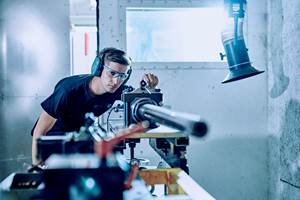DSM Dyneema, Airborne International collaborate on radomes
DSM Dyneema works with Airborne International to apply DSM technology to a ground-based radar system that requires durability, electromagnetic transparency and high strength.
DSM Dyneema (Herleen, The Netherlands; Greenville, NC, US), manufacturer of ultra high molecular weight polyethylene (UHMWPE) fiber, branded as Dyneema, has formed a partnership with Airborne International (The Hague, The Netherlands) to develop and produce radomes featuring Dyneema Crystal Technology.
With what DSM Dyneema says is near-zero signal loss, Dyneema Crystal Technology is setting new standards for electromagnetic transparency, as well as light weight, strength and hydrophobic performance. The partners will deliver next-generation radomes to companies including initial customer Pro Patria Electronics (Budapest, Hungary) for its PGSR-3iFT Beagle tower-mounted ground surveillance radar.
“Our tower-mounted ground surveillance radar faces tough, unrelenting challenges in the field,” says Miki Kohen, technical director of Pro Patria Electronics. “We needed a breakthrough radome design to support and enhance its capabilities and we found the ideal solution by working with Airborne and DSM Dyneema. Dyneema Crystal Technology not only exceeded our high expectations for performance, but it also addressed a wide spectrum of challenges, from protection to portability. This unique material has the potential to transform our industry in a big way.”
The Pro Patria PGSR-3iFT Beagle is a tower-mounted radar used to detect, track and classifiy targets moving on or close to the ground. Designed for deserts and other harsh environments, it is a key component of sensor systems for early warning, border incursion prevention and threat recognition. The cylindrical radome developed by DSM Dyneema and Airborne for this application uses high-performance Dyneema Crystal Technology in tape form and is approximately 1m in diameter and 1.2m in height.
“Dyneema Crystal Technology takes a radically different approach to radar protection, enabling us to raise the bar in radome design and production,” says Giel van der Kevie, commercial manager of Airborne International. “This technology gives our company a powerful new solution to address higher frequency challenges and requirements for near-zero signal loss. Together with our partner, DSM Dyneema, we are investigating new ways to leverage the distinctive properties of Dyneema Crystal Technology to benefit our customers.”
“Our Premium Manufacturing Partnership with Airborne International will enable us to offer radically new designs to the radomes industry,” says Danielle Petra, business development manager at DSM Dyneema. “Drawing on our complementary strengths and shared focus on innovation, we are leveraging Dyneema Crystal Technology to re-imagine radome capabilities and maximize radar performance.”
Dyneema says its Crystal Technology provides an extremely low loss tangent and approximately half the dielectric constant compared to aramid, E-glass and quartz. The electrical properties of the material maintain superior performance, even at higher frequencies from X band to millimeter band, allowing military, civil and telecommunications organizations to realize the full potential of their advanced antenna, radar, radio astronomy or communications systems.
Further, because Dyneema Crystal Technology offers an exceptional strength-to-weight ratio and high impact resistance, it can be used in thinner gauges that enhance transmission quality even more. Its light weight also makes radomes more energy-efficient to ship and easier to maneuver and install.
The material, which can be supplied as tape or fabric, is inherently hydrophobic without the need for time-consuming and demanding resin application. This property also virtually eliminates the need for regular maintenance.
Related Content
TenCate Advanced Armour renamed to Integris Composites
With its rebranding, Integris maintains the ability to develop, test and manufacture ballistic armor and survivability solutions while expanding into new markets where composite solutions can be advantageous.
Read MoreAirbus presents unmanned Wingman concept
Fighter jet model unveiled at ILA Berlin, made from an iron structure and composite outer skin, will deliver more tactical options, supporting future combat missions.
Read MoreIndustrializing additive manufacturing in the defense/aerospace sector
GA-ASI demonstrates a path forward for the use of additive technologies for composite tooling, flight-qualified parts.
Read MoreFarnborough Airshow 2024 brings together aerospace innovation, collaboration
The week-long international airshow provided a hub for new announcements made by Boom Supersonic, Airbus, Boeing, GKN, GE, ZeroAvia, Eve, Bell, VoltAero, Eve and Lilium. CW has compiled several below.
Read MoreRead Next
VIDEO: High-volume processing for fiberglass components
Cannon Ergos, a company specializing in high-ton presses and equipment for composites fabrication and plastics processing, displayed automotive and industrial components at CAMX 2024.
Read MoreDeveloping bonded composite repair for ships, offshore units
Bureau Veritas and industry partners issue guidelines and pave the way for certification via StrengthBond Offshore project.
Read MorePlant tour: Daher Shap’in TechCenter and composites production plant, Saint-Aignan-de-Grandlieu, France
Co-located R&D and production advance OOA thermosets, thermoplastics, welding, recycling and digital technologies for faster processing and certification of lighter, more sustainable composites.
Read More















.jpg;maxWidth=300;quality=90)










